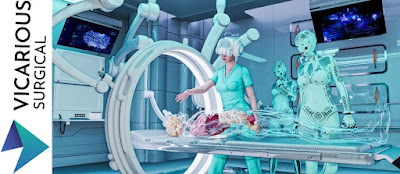Vicarious Surgical
Vicarious Surgical raised another $10m, to complete its VR-controlled micro-robot technology:
"The company’s co-founders, Adam Sachs and Sammy Khalifa, have been
developing and refining the technology almost since they met at the
Massachusetts Institute of Technology as undergraduates.
The
27-year-old Sachs said that he and Khalifa formally launched the company
roughly five years ago when they graduated from MIT, and have been
working on it ever since.
“We’ve been working on ways to
miniaturize robotics and put all of the motion of surgery into the
abdominal cavity,” says Sachs. “If you put all of the motion inside the
abdominal cavity you are not confined to motion around the incision
sites.”
What really set the founders’ brains buzzing was the
potential for combining their miniature robots with the ability to see
inside the body using virtual reality headsets like the Oculus Rift.
The two founders initially bootstrapped their startup and then raised
a small seed round, then began steadily closing larger tranches of a
rolling round from luminaries like Bill Gates through his Gates Frontier fund, Khosla Ventures,
Eric Schmidt’s Innovation Endeavors, AME Cloud Ventures (investment
firm from Yahoo founder Jerry Yang), Singularity Holdings investor Neil
Devani and Salesforce founder Marc Benioff.
In all, the company has raised some $31.8 million to support the development of its technology.
According to Sachs, a number of innovations in robotics has led the company to develop what Sachs calls tiny humanoid robots.
“Picture
a very robotic version of two human arms and a human head,” says Sachs.
“Two robotic arms that have the same degrees of freedom and proportions
of a human arms and a camera that is placed above the shoulders of the
robot… it’s a few inches across.”
Using the motorized robot a surgeon can remotely control the robot’s movements to operate on a patient. “They can be in another room or they can be hundreds of miles away (with an excellent internet connection,” says Sachs.
For
surgeons using Vicarious’ technology, the primary feedback is virtual,
Sachs says. They look through the “eyes” of the robot and can look down
and see the robot’s arms. “We track the surgeon’s arm motion and mimics
their arms and hands. The primary feedback is to create the impression
of presence of the surgeon as if they’d been shrunk down.”
The
mission of Vicarious Surgical’s founders and its investors is to drive
down both the cost of higher impact surgeries and access to the best
surgeons through remote technologies.
The company is currently testing its miniature robots in laboratories
and would not comment on whether it was using animal subjects.
Vicarious is also modeling the human abdomen and conducting as many
virtual tests as possible.
The new funding, Sachs says, will take the company through its applications for the Food and Drug Administration. "
Source: TechCrunch



Comments